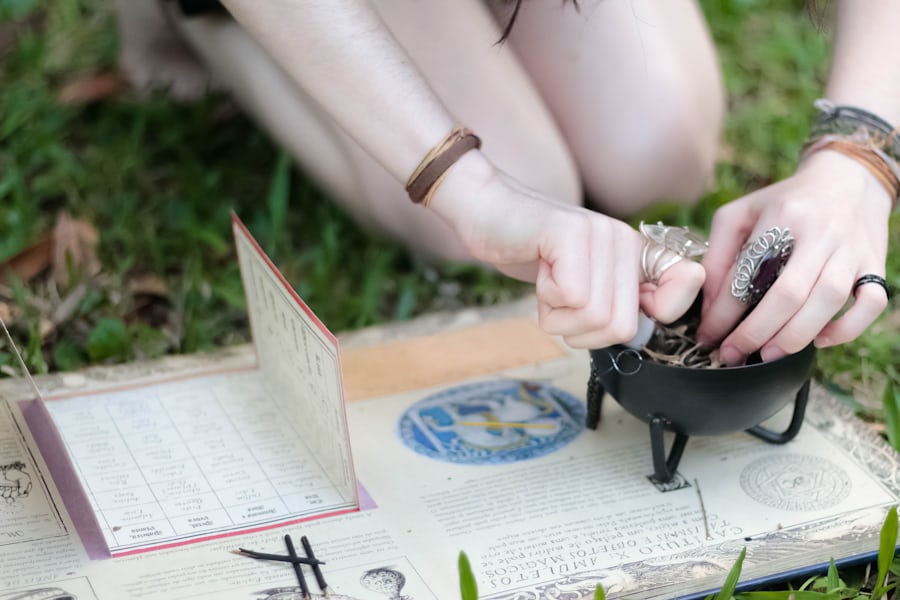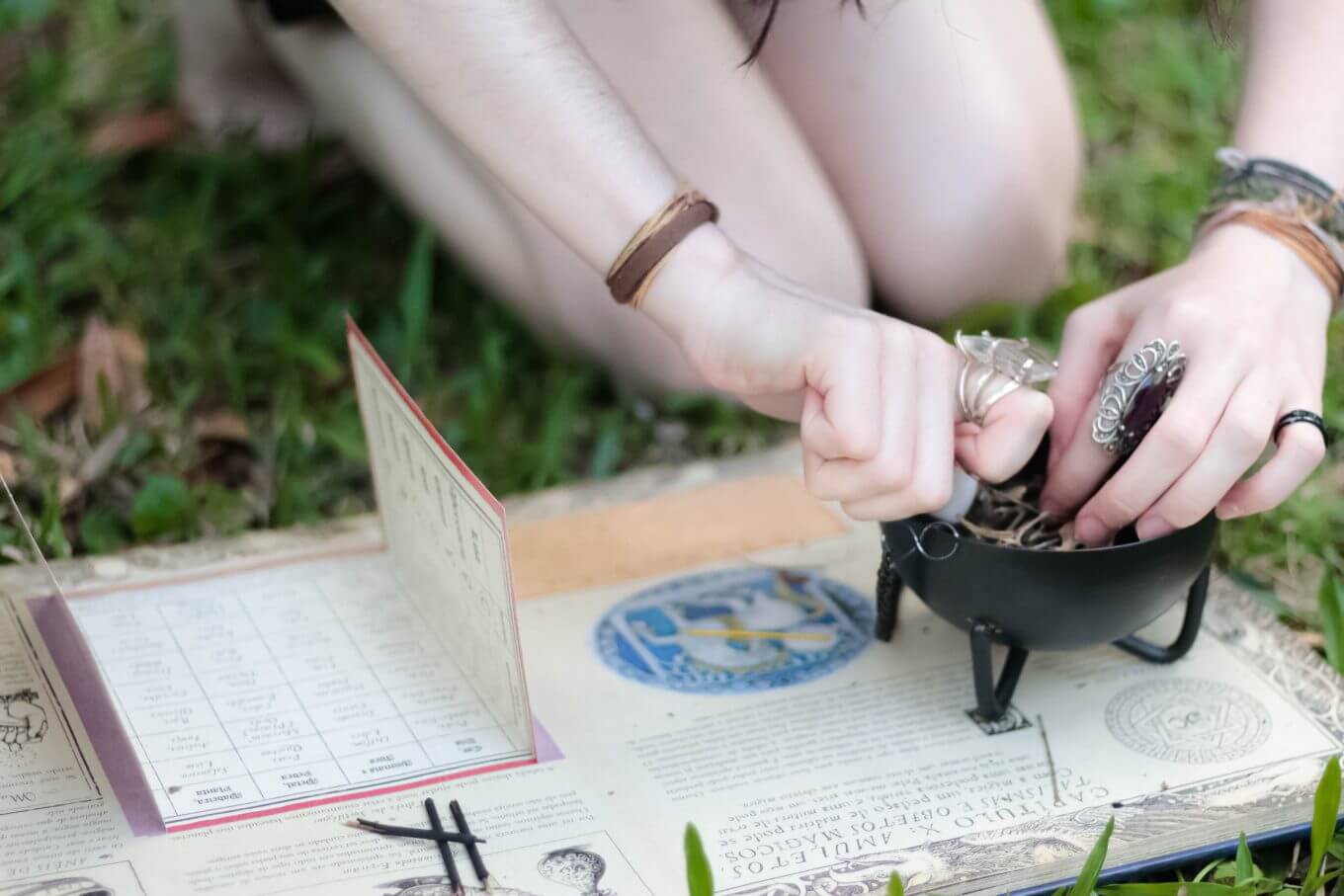Wicca is a neo-religious religion that, despite its widespread and fame, is often misinterpreted. Especially with the actual history and traditions of this new witchcraft is sometimes taken a walk. Even informative websites and encyclopedias sometimes indulge in inaccuracy or repeat uncritically clichés about Wicca and Wiccans. So it’s time to put things right, and to answer questions like, “Is Wicca really an age-old religion” and “were her followers ruthlessly persecuted?” “Do Wiccans worship the devil and do they speak curses?” “And is it true that witches have been writing in the Book of Shadows for centuries?”
“Witch” or “Wicca(s)”?
Often the names ‘witch’ and ‘Wicca‘ or ‘Wiccan’ are used interchangeably without a clear distinction. When Wicca came into existence in England and in the United States, the followers of the new religion decided to renounce the name “witches” because it had a negative connotation. In the meantime, neo-pagans have apparently reconciled themselves with the old name, which is no longer immediately associated with harmful magic.
Different definitions of Wicca and the new witchcraft
The Wicca & the New Witchcraft have different definitions. Some of the false claims about Wicca have to do with confusion of understanding. When we talk about ‘witchcraft’, this can have three possible different meanings:
- the practice of sorcery and witchcraft worldwide. It is about witchcraft in tribal societies (Africa, New Guinea, Congo, etc.) as it is studied by anthropologists;
- witchcraft in the opinion of the European witch-persecutors as harmful, demonic magic;
- modern neo-tendency movements such as Wicca with their emphasis on respect for life and nature. Wicca as “white magic” is a mixture of ritual magic and religion.
By confusing these categories of meanings, misconceptions arise.
“Wicca is an age-old religion”
Error: Wicca originated in the mid-20th century. The founder was the Englishman Gerald Gardner, who in turn was heavily inspired by the writings of egyptologist Margaret Murray. She claimed that witches had actually existed in Europe as a cult prosecuted by Christians. Researchers have since rejected this idea as an unscientific fantasy. However, Wiccans continue to believe in it, despite the fact that there is no evidence for the existence of such a cult. Historically it is true that in many pre-modern Western societies magic and witchcraft were part of popular belief. However, there was no question of religion or of a cult that worshiped devils and demons. That negative image of the witch became dominant from the late Middle Ages and would also influence our fairy-tale writers.

“Wicca is the name that Gardner gave to his form of witchcraft”
Error: Gardner never referred to religion as “Wicca,” but sometimes referred to practitioners as “wica” (with one c). He called the religion itself “the Craft of the Wise”, “witchcraft”, or “the witch-cult”. He adopted the latter name from Margaret Murray’s witch-cult hypothesis.
“Wiccans were persecuted for centuries and almost wiped out”
Wrong. Wiccans or Wiccans as self-proclaimed witches nowadays call themselves, did not yet exist at the time of the witch persecution in Europe (15th to 18th centuries). Incidentally, real “witches” were not convicted during the witch prosecutions. They were just innocent victims, mostly women, who were suspected of witchcraft. Antiquity reports are known for prosecutions of individuals accused of sorcery. Only at the end of the first millennium could so-called witches be punished by the Church for engaging in magic and witchcraft. Religious persecution of alleged witches only started in the 14th century. But all this has nothing to do with 20th-century Wicca.
“Wicca is against Christianity”
Wrong. This misconception is somewhat a consequence of the assumption that modern Wiccans are the spiritual heirs of persecuted witches from the past. Wicca is a tolerant religion. It is therefore not necessary to renounce Christianity or other religions to practice Wicca practices: there are, for example, Christian, Jewish, and Buddhist Wiccans.
“Wicca is not a religion”
The idea of recognizing Wicca as a religion still encounters a great deal of misunderstanding. In the Christian West, religion is thought to be a highly centralized organization, local buildings (churches) with a priest in every church, and a single male deity. There is no question of all this at Wicca. The most controversy is that Wiccans also call themselves ‘witches’, as a result of which Christians make the association with Satanists. However, Wicca is now accepted as a religion in various tolerant countries. Also in the Netherlands, for example,religious freedom. Because of the fairly complex set of doctrines concerning the spiritual aspects of their way of life, as well as the ceremonies and structure, it was already thought in the US in the 1980s that there was sufficient reason to recognize Wicca as a religion.
“Wicca is a result of the new age”

This is not true, because the new age only dates from the seventies of the 20th century and is, therefore, a much younger movement. Most Wiccans, therefore, deny the association with the new age. Ronald Hutton, the historian of the new witchcraft, noted in his 2001 study The Triumph of the Moon: A History of Modern Pagan Witchcraft that Wicca is not only older than new age but also differs considerably in philosophy. Within Wicca, there are in practice many variations and interpretations of the original teachings of Gerald Gardner (“the father of modern witchcraft”, 1884-1964) and Doreen Valiente (“the mother of modern witchcraft”, 1922-1999). One of the more superficial variants, whose followers are called ironically fluffy bunnies, does incorporate many elements from the New Age movement. By definition, these fluffy bunnies (‘fluffy bunnies’) take on everything without looking into it or critically examining it, and the reputation of serious students of Wicca nevertheless has the reputation of being a religiously exalted an annoying know-it-all.
“Witches and Wiccans have special powers”
That witches possess or have special powers, such as being able to fly and pronouncing curses, is the result of the absurd accusations of the witch persecutors during the Renaissance. There are also convictions of sorcery in popular belief, ancient Romans’ law, and in the Bible, although it is not called “witchcraft.” Superstition can be found in all times and in many cultures. It is true that the new witches perform rituals, but they mainly have to do with expressing a deep connection between man and nature.
“A Wiccan must master occult arts, such as divination”
Tarot, commuting, dowsing, making astrological predictions, etc. are not directly related to Wicca. However, during initiation, which can take several years, these skills and arts are often taught. Magical practices such as forecasting and calling up spirits are therefore allowed but are not an integral part of Wicca.
“Wiccans spell curses”
That would be rather atypical for Wicca, which focuses on harmony and well-being. Here too there is confusion with stereotypical stories about malicious witches and Satanists. Wiccans do cast magic spells and make magic potions that are meant for healing, wisdom, love, and creativity. Some practitioners use runes or candle magic as a means to evoke these desired things.
“The new witches worship the devil” The Horned God
That Wiccan is worshipers of the devil is wrong. The devil / Lucifer / Satan is a Jewish-Christian concept that is not part of what Wiccan supporters believe. Because of its external resemblance, the “Horned God” is confused with the devil, with Satan, and also the use of the five-pointed pentagram leads to the false conclusion that Wicca has something to do with satanism. In its simplest form, Wicca is a duotheistic religion, with a female Great Mother Goddess (or Trinity Goddess) and a male Horned God.
The Horned God is an archetypal deity. Gardner was inspired by the Celtic god Cernunnos and the Greek god Pan as personifications of nature, life and animal instinct. Gardner presented his horned male god as the God of ancient witches and was supported in this by the witch culture theory of British anthropologist Margaret Murray. Horns are traditionally a sacred symbol of virility, and male deities with horns or antlers were common in ancient pagan religious iconography.
The pentagram in Wicca and the new witchcraft

In Wicca and the new witchcraft, the pentagram symbolizes the union of the five basic elements: fire, air, earth, water and spirit and is therefore not directed against Christian values, as is sometimes assumed. Early Christians wore the pentagram as an emblem that possibly represented the five wounds of Christ, but the pentagram as a magic symbol existed long before that time. For example, the symbolic assignments with the classical four or five elements date back to Greek antiquity (5th century BC). The association with Satanism is also a misconception since Wiccans have nothing to do with Satan. The pentagram of Wicca is carried by 1 point upwards, while in Satanism it is carried by 1 point downwards.
“All Wiccans are feminists”
Although it is true that some Wiccans (individuals and groups) are attracted to this belief by the Goddess, and also attribute it to more important, within the pantheon of Wicca there are simply male gods. Wicca, therefore, stands for equality of the male and female principle, and not for female superiority. In some traditions, however, especially in the feminist branch of Wicca (Dianic Wicca, born in the United States in the 70s), the Goddess is seen as complete, and God is not even worshiped at all. So the focus here is on matriarchal feminism.
“The Book of Shadows is a book in which witches have been passing on their knowledge for centuries”
Wrong. Firstly, as said, there was no sect at all with witches from centuries-old times, and secondly, it is a tradition that Gardner, the founder of Wicca, started in the 20th century. Gardner had borrowed this idea for a “witch grimoire” in which the witch wrote down everything she had learned (spells, rituals, recipes, etc.) from English occultist Aleister Crowley. Although Grimoires existed in the late Middle Ages, they would exert a great deal of influence on magical orders, such as the Golden Dawn from the 19th century. Gardner’s Book of Shadows, however, was rather an individual diary that the witch kept in the tradition of Wicca.
Conclusion
Despite the fact that Wicca was originally the 20th-century invention of one man, many supporters remain convinced that their new religion is somehow a continuation of a secret (underground) religion of witches that has remained hidden for thousands of years until the Church began to persecute them. They emphasize the similarities between ancient pagan customs and the beliefs and practices of their faith. However, Wicca and the new witchcraft simply combines surviving folk traditions with modern elements, which is called syncretism. It is loosely based on all kinds of Western European pagan customs and (magical) rituals that were performed for centuries in the context of the cycles of the seasons, such as the celebration of the harvest. The continuity that they think they see in the new witchcraft of the past and now, however, cannot be demonstrated and is extremely unbelievable.
